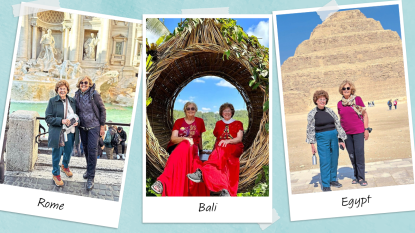8 Ancient Marvels That Are So Impressive, You Just Might Have to Pinch Yourself To Know They’re Real
Go back in time.
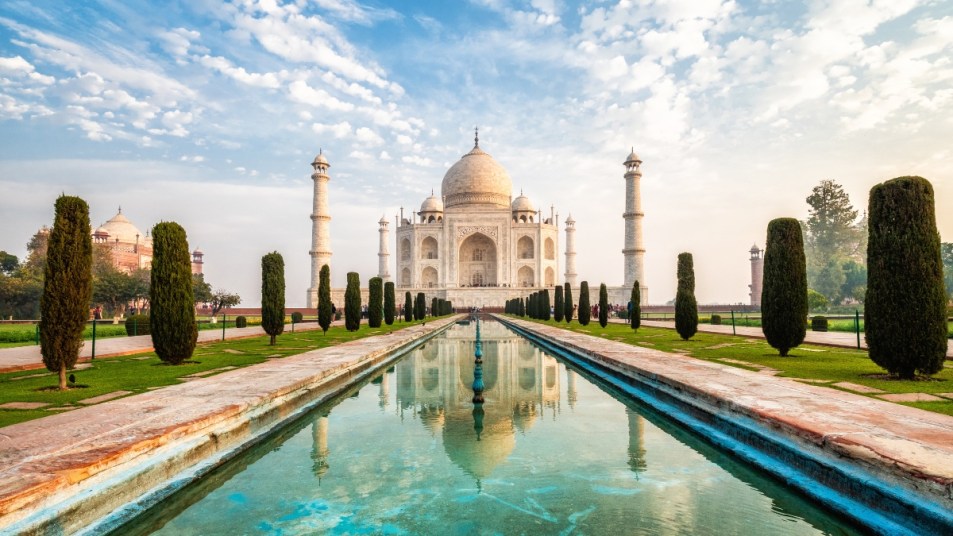
In the presence of ancient wonders, our day-to-day problems are put into perspective and stress almost seems to fade away. Visitors to these awe-inspiring spots often find themselves transported to another place as they take in the mysterious spectacles. What did people do here? How did they come to be? Who was responsible for their construction? While we might have some of the answers thanks to researchers and explorers over the years, many questions remain. Awaken wonder at iconic monuments like Machu Picchu, Stonehenge, Petra, Mesa Verse National Park, and more.
1. Angkor Watt (Cambodia)

The ancient city of Angkor, once home to as many as a million people, bears testament to the power and wealth of the Khmer Empire, which ruled the majority of Southeast Asia between the 10th and 13th centuries. Spanning more than 250 square miles, the Angkor Archaeological Park protects more than 1,000 buildings, including the main Angkor temple. This is the biggest pyramid in Asia and considered a masterpiece of Khmer architecture.
More than 200 million people a year typically come to behold this UNESCO World Heritage site. Most purchase a multi-day pass to take in the many ornate temple complexes and sights, which include the Bayon, Angkor Thom, Ta Prohm, Preah Khan, Banteay Srei, and the Angkor National Museum.
Photographers gather at sunrise to capture the five lotus-shaped pinnacles of Angkor Wat silhouetted against the sky and mirrored in its reflecting pool, while Phnom Bakheng is a popular spot to watch the sunset. On an even grander scale than Angkor Wat, the ancient capital of Angkor Thom boasts five gates, a moat, the Terrace of the Elephants, and an avenue lined by deities in vivid depictions of good and evil.
More than 200 giant faces of Avalokiteshvara gaze down from the 50 towers of the Bayon, built at the peak of Khmer power in the 12th century and considered one of Angkor’s greatest achievements. Relief carvings depict the mundane activities of everyday life, giving a window into living history. Still overgrown by strangler figs and largely unexcavated, the Ta Prohm temple complex is one of Angkor’s most evocative. It offers a chance to imagine what these dramatic ruins looked like when they were rediscovered by outsiders in the 19th century. The nearby Ta Kea temple shows off intricately carved towers, and its steep stairs discourage crowds.
Visiting Tips
The closest city, Siem Reap, has an international airport and lodging options ranging from cozy (Sokkhak Boutique Resort and Mémoire D’Angkor) to expansive (Sofitel Angkor Phokeethra Golf & Spa Resort). Consider hiring a tuk-tuk (a motorized two-wheel carriage) for the day to take you between temples, renting a bike to get around, or joining a van tour. Find the best coconut rice cakes, beef skewers, rice noodles, and other street food in the Old Market and in the night food stalls on Street 9 in front of it.
2. Petra (Jordan)

Carved directly into the sheer faces of gravity-defying sandstone cliffs, the towering tombs, temples, and monumental structures of Petra demonstrate the power of the Nabataean kingdom that thrived in southwestern Jordan between 300 B.C. and 100 A.D., prior to the Roman conquest. Known as the Lost City for hundreds of years when it had all but faded into myth, Petra was fiercely guarded by the Bedouins who lived in the region. Then, in 1812, a Swiss explorer tricked his way into it and reintroduced the ruins to the wider world.
The walk into this ancient site is a marvel unto itself. The path snakes through the narrow gorge known as the Siq. Here, cliffs rise 240 feet high on either side, preventing any glimpse of the monuments until the last minute. Once inside the complex, top sights include the Treasury — the massive facade made famous by Indiana Jones — as well as the Royal Tombs, the monastery (aka Al-Deir), and the High Place of Sacrifice, a clifftop overlook with panoramic views.
Derived from the ancient Greek word for rock, Petra is an apt name for the enormous site, scattered across a vast expanse of mountains, basins, washes, and canyons, and connected by trails and steep stone staircases. Many visitors opt for camel or donkey rides in the area and hire experienced guides to help access lesser-known viewpoints. Those who book the impressive Petra by Night tour will walk through the Siq lit with 1,500 candles and experience the treat of traditional Bedouin music and storytelling.
Visiting Tips
Home base for any Petra visit is the town of Wadi Musa. The closest stay is Petra Guest House, within the park itself. The popular Petra Moon Hotel is only a bit farther. Petra is a three-hour drive from Queen Alia International Airport outside of Amman. Smaller Aqaba King Hussein International Airport is closer, at 78 miles away. Purchase the Jordan Pass online so you can enter the gate first thing without waiting for the ticket office to open. Many visitors combine Petra with a stay in Wadi Rum, whose martian-like red sand landscape is sure to stun.
3. Taj Mahal (Agra, India)

There are many monuments to love in this world, but none are as breathtaking — and heartbreaking — as the Taj Mahal. Located in Agra in the state of Uttar Pradesh, this palace is one man’s everlasting tribute to his beloved. Mughal emperor Shah Jahan spent 17 years, from 1631 to 1648, building his masterpiece as a mausoleum for his wife, Mumtaz Mahal, who died giving birth to their 14th child.
Tourists get their first glimpse while passing through an arched entryway — the monument’s signature onion dome and four symmetrical minarets rising behind a long reflecting pool. Almost everyone stops to pose for photos before walking forward slowly, absorbing every nuance. Once close enough, admirers realize the white marble is inlaid with intricate patterns of precious and semiprecious stones. This creates elaborate works of art up close.
As the sun inches higher and the marble changes from dusty rose to golden beige, magnificent details come into perfect focus: floral mosaics in turquoise, lapis, coral, and onyx, and intricate carvings that include verses of the Koran. The tomb itself — which now holds both Mumtaz and Jahan — lies directly beneath the dome. Beholding their eternal resting place is a chance to reflect on the power of love and its ability to create wondrous things.
Visiting Tips
The Taj Mahal is open Saturday through Thursday from sunrise to sunset, and full-moon visits are also possible five days a month. Check tajmahal.gov.in for information and tickets. The palace is located in Agra (about 127 miles from Delhi), and The Oberoi Amarvilas hotel sits just 650 yards away, offering 24/7 views.
4. Stonehenge (England, UK)
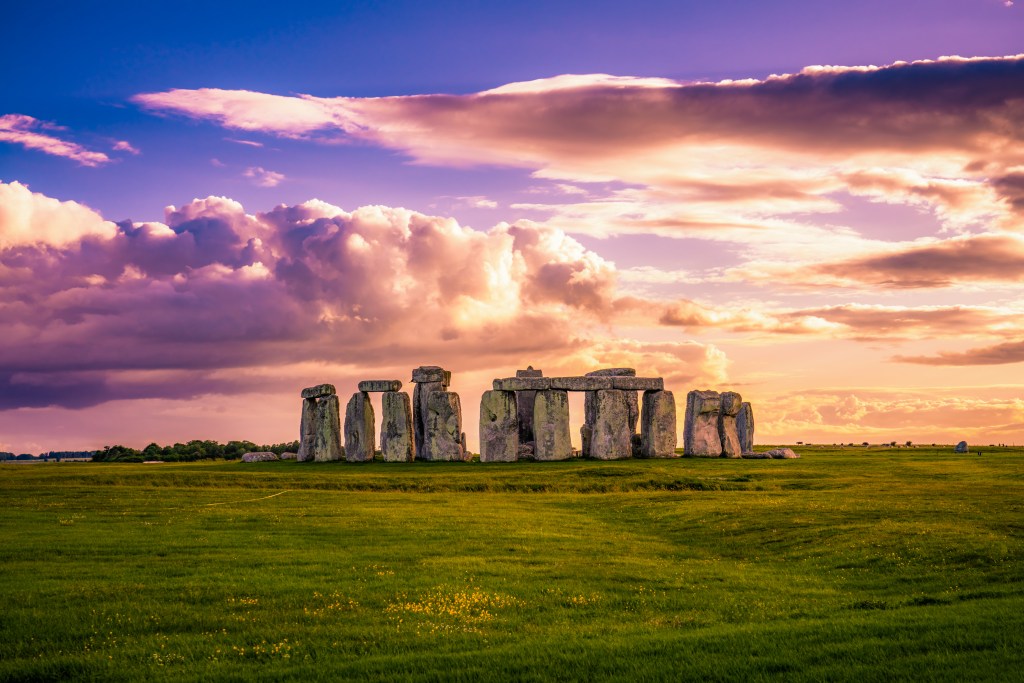
Actual facts about Stonehenge — a UNESCO-listed stone circle believed to have been built in several phases by Neolithic and Bronze Age peoples — are hard to come by. Questions about its origin, construction, and use have plagued scholars for centuries. But one thing is hard to refute: It inspires an almost transcendent mysticism. Thousands of pilgrims gather here every
summer solstice to feel the monument’s energy for themselves, while even casual sightseers
sense the magic, as the 97-foot-wide marvel materializes out of the mist. Enduring for 5,000
years and even predating the Egyptian pyramids, the site still serves as a sort of metaphorical compass, orienting visitors to their place in the vastness of space and time. Fifty massive sarsen stones and 43 smaller bluestones remain at Stonehenge today, arranged in horseshoe and circular ormations. Travelers must stay behind ropes, but can still appreciate the scale of the sarsens, the largest of which towers 24 feet and weighs more than 40 tons.
Recent archaeological findings suggest the source of the sarsens was West Woods, 15 miles
away. Amazingly, the bluestones — weighing up to 4 tons each and reaching heights of 6 feet — likely came from the Preseli Hills in Wales, some 200 miles away. Researchers still debate whether they were transported by sledges, rollers and rafts, or by Ice Age glaciers. Stonehenge’s purpose remains perhaps the greatest mystery of all. The discovery of 64 cremations at the site indicates its function as a burial ground. However, the monument may also have been a temple, a calendar, or a place of healing. For the tourists who have been flocking here since the time of the Romans, it is spectacular, if not still downright sacred.
Visiting Tips
To get a closer look at Stonehenge, book a Stone Circle Experience. This is a small-group tour that they hold outside of normal operating hours. Stay in Salisbury, about 1.5 hours from London by train. While in town, visit the Salisbury Cathedral. This boasts England’s highest spire, along with the best-preserved copy of the Magna Carta. You can also wander the ruins of Old Sarum, a hillfort dating to 400 B.C.
5. Machu Picchu (Peru)
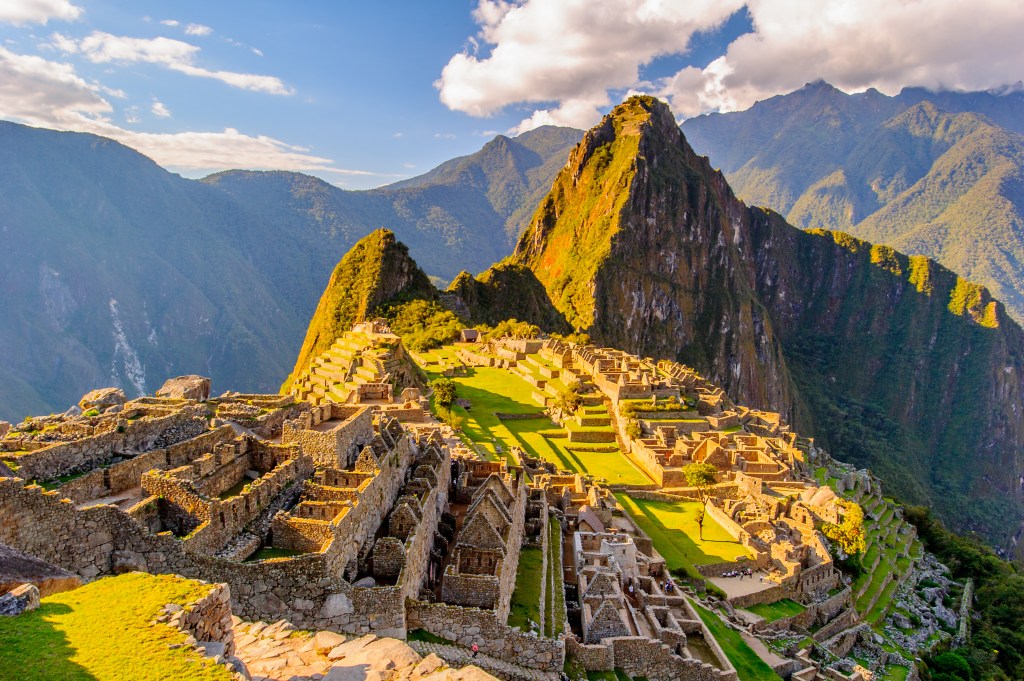
Travelers who know the awesome feeling of arriving somewhere after a physically challenging hike should undertake the Inca Trail to Machu Picchu. It is one of the most towering achievements of the Incan Empire. After trekking 26 miles at altitude for four days, hikers are excited to reach the Sun Gate, which offers the iconic view of the monument. Even those who take the train from Cusco and enter via the main tourist gate can enjoy the incredible panorama from this spot, after completing a less-strenuous one-hour hike up from the ruins.
A marvel of Incan engineering, the citadel is comprised of 150 buildings that were constructed with polygonal stones precisely cut to fit together without mortar. From the Sun Gate, with towering Huayna Picchu Peak behind it, this UNESCO World Heritage site resembles a sleepy village in the clouds. It’s a perfect place to strike a meditative pose.
Scholars have determined that the citadel, built for the Inca king Pachacutec, was a sacred center that once had 300 to 1,000 inhabitants. It was eventually supplanted by newer cities and lost to memory — until British professor Hiram Bingham rediscovered it in 1911. Today, as many as 1.5 million annual visitors typically wander amid the carefully chiseled stones, marveling at the ingenuity required to construct it.
Visiting Tips
There are only two ways to get here: Hike the Inca Trail, or take a four-hour train ride from Cusco (or two hours from Ollantaytambo in the Sacred Valley). The town of Aguas Calientes has several atmospheric hotels, but only the Belmond Sanctuary Lodge has a view of the ruins. Comfortable shoes are a must for climbing centuries-old stone staircases and uneven pathways.
6. Pyramids of Giza (Cairo, Egypt)

Stand at the base of Egypt’s Great Pyramid of Giza — the largest of the group at 451 feet tall — and it’s hard not to be wowed while feeling small and wondering how architects masterminded this feat 4,500 years ago. Each stone weighs between 2.5 and 15 tons and challenges even modern construction, although seasonal flooding is believed to have assisted with the heavy lifting. Today, these limestone relics remain the only of the ancient Seven Wonders of the World still standing. This is largely thanks to the precision of the building, calculated down to the millimeter. What’s more, the corners of the pyramid orient to the cardinal compass directions.
Mystery looms as to why and how these were built. The leading answer is that each is a tomb for a pharaoh. They helped these rulers pass into the afterlife with much material wealth. The how is harder, given the intricacy of the interior chambers, passageways, and air shafts. Construction required 2.3 million blocks and took approximately 20 years — and the labor of some 20,000 men.
The area of Giza Plateau is home to the great pyramids of Cheops, Chefren, and Mykerinus, as well as the Sphinx, plus a handful of additional tombs, temples, burial grounds, and other sites of significance. The list includes the Solar Boat, crafted to allow King Khufu to travel with the sun god Ra; it’s preserved inside a museum of the same name. The Valley Temple of Khafre, dating to the 26th century B.C., stood as a mummification-process grounds and was only uncovered in the 1850s. Together, this collection, recognized as a UNESCO World Heritage site in 1979, still feels timeless and transportive, carrying imaginations back millennia.
Visiting Tips
Devote at least a half-day to the Giza necropolis, a 40-minute drive west from central Cairo. Book a guided tour to bundle transportation, save time, and gain a more in-depth understanding of the history. From March to November, the best time to visit is early morning midweek. Stay at the Marriott Mena House, with an excellent view of the pyramids lit up at night, or at nearby Great Pyramids Inn, where you can sip tea on the rooftop terrace.
7. Mesa Verde National Park (Colorado)
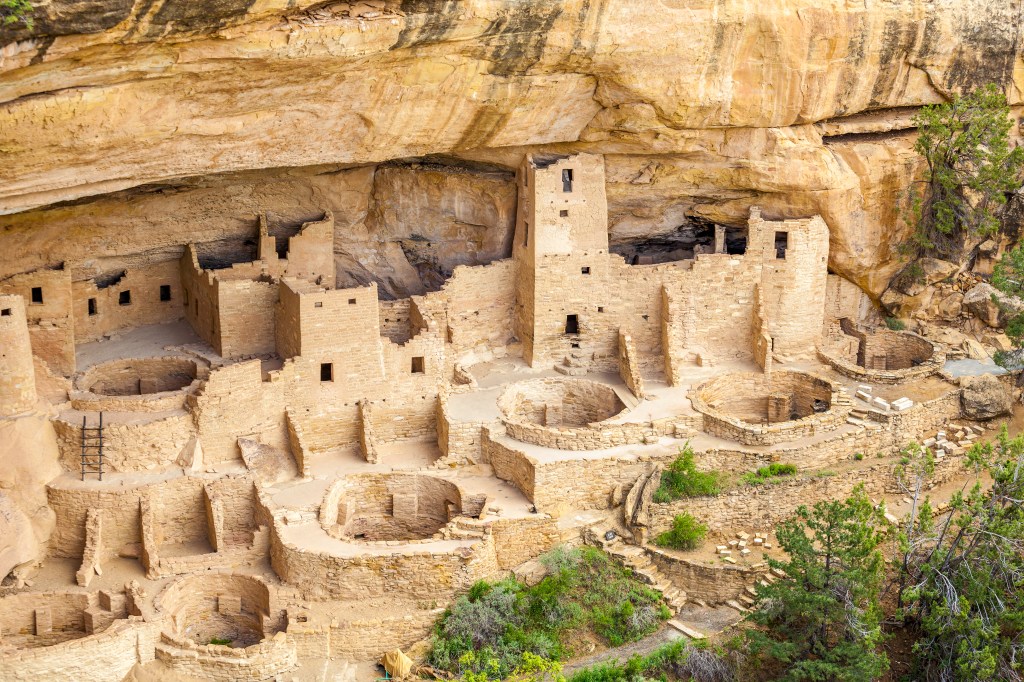
Beneath the sandstone alcoves of Mesa Verde National Park hides a millennia-old network
of Ancestral Puebloan cliff dwellings, making up the country’s largest archaeological preserve and very first UNESCO site. Tucked into what’s now Colorado’s southwest corner, a city of some 20,000 people flourished from 600 to 1300 A.D., sleeping in the canyon walls for their last 100 or so years in the area before abruptly deserting it.
The city remained asleep in the walls, though, largely untouched for 500 years. In recent centuries, the Ute tribe settled in the region. However, they didn’t disturb the dwellings, regarding them as sacred ancestral sites. But by the late 1880s, word spread of the structures, attracting novice archaeologists, treasure hunters, and vandals. President Theodore Roosevelt declared the site a national park in 1906.
The top archaeological draws are located in Chapin Mesa (open year-round) and Wetherill Mesa (open May to September). Both offer stunning overlook views of the best-preserved dwellings, but opportunities to explore them up close are few. To enter most of the cliff dwellings, you must be on a ticketed tour. Visitors climb two 15-foot ladders into Long House’s sandstone alcove to explore the dwelling’s 150 rooms, then hike or bike the 5-mile Long House Trail to see overlooks of Kodak House, Long House, and the Nordenskiold cliff dwellings. On the Balcony House tour, you’ll climb a 32-foot ladder, crawl through a 12-foot tunnel, and scale a 60-foot cliff.
From any vantage point, the remains of the Puebloans’ elaborate cliff dwellings are a breathtaking portal into North America’s prehistoric culture. They tell the story of the Indigenous population’s development long before European colonization.
Visiting Tips
It’s an hour drive to the dwellings from the park’s entrance, so overnight inside the park at Far View Lodge. Enjoy a gourmet dinner at the lodge’s Metate Room, boasting a wall of glass overlooking the plateau (reservations can only be made within 24 hours of your stay). Tickets for ranger-guided tours (May through October) are available up to 14 days in advance at recreation.gov. There is currently no access into Chapin Mesa’s famous Cliff Palace. However, you can still view it from Sun Temple on Mesa Top Loop Road. The Petroglyph Point trailhead offers a wonderful vista of Spruce Tree House.
8. Cappadocia (Turkey)

With its multicolor rock towers shaped like giant mushrooms, witch hats, and turrets, Cappadocia’s volcanic landscape feels straight out of a fairy tale. No wonder this natural wonderland has become one of Turkey’s most beloved destinations. Here, travelers come to hike among the fantastical formations, explore underground cities, and stay in hotel rooms whittled into the beehive-shape domes known as “fairy chimneys.”
Whole communities were carved out of the soft rock know as “tuff” — formed from the ash of ancient eruptions — as various waves of people took shelter from invaders. More than 200 ancient underground cities dot the region, some dating as far back as the Phrygians in the eighth to seventh centuries B.C. The best-developed of these are Derinkuyu and Kaymakli. Tours of both descend as far as eight stories underground through tunnels and rooms used for cooking, sleeping, learning, wine storage, and worship. Among the most beautiful of Cappadocia’s ancient cave buildings are the rock-cut churches decorated with Byzantine mosaics and frescoes. Some are set high on the cliff face and are accessible only by ladder. The Göreme Open Air Park, a UNESCO World Heritage site, protects the largest number of these 10th-and 11th-century churches and monasteries in one place.
Most people do at least one hike or walk to immerse themselves in the drama of the landscape. The rock castle of Uçhisar — the highest point in Cappadocia — offers astonishing views at any time of day, but it’s particularly divine at sunset.
Visiting Tips
Accommodations, eats, and shopping cluster in Cappadocia’s two main towns, Uçhisar and Göreme. Both towns boast numerous “cave hotels” featuring rooms that are carved into the rock. The Museum Hotel in Uçhisar is a luxury boutique option with an excellent restaurant. Additionally, Cappadocia Cave Suites in Göreme has a medieval ambience. Two regional airports, Nevsehir and Kayseri, have frequent flights from Istanbul.
A version of this article appeared in our partner magazine The World’s Most Amazing Places.













